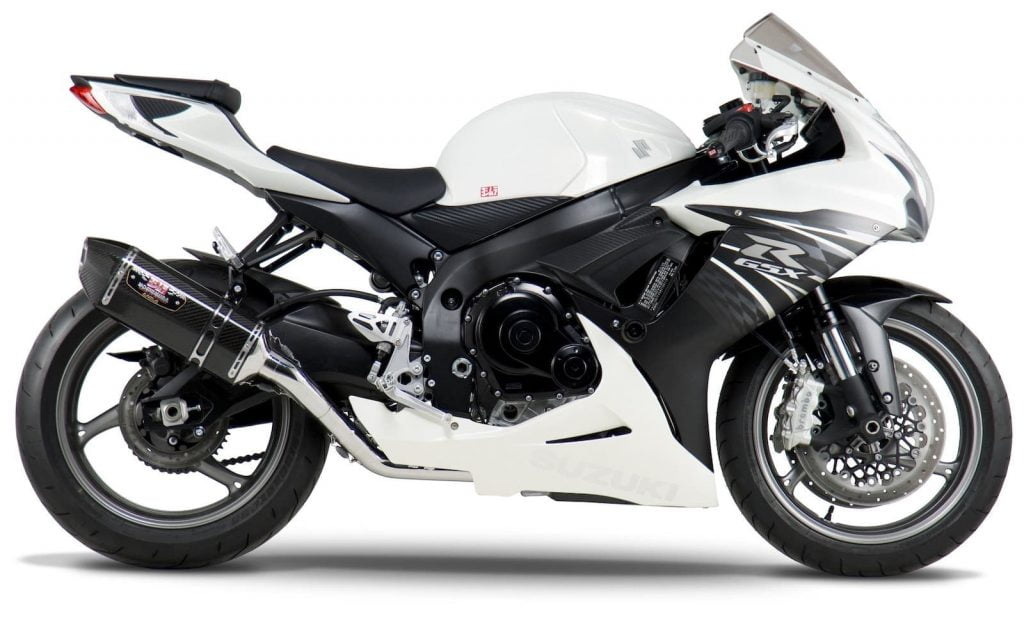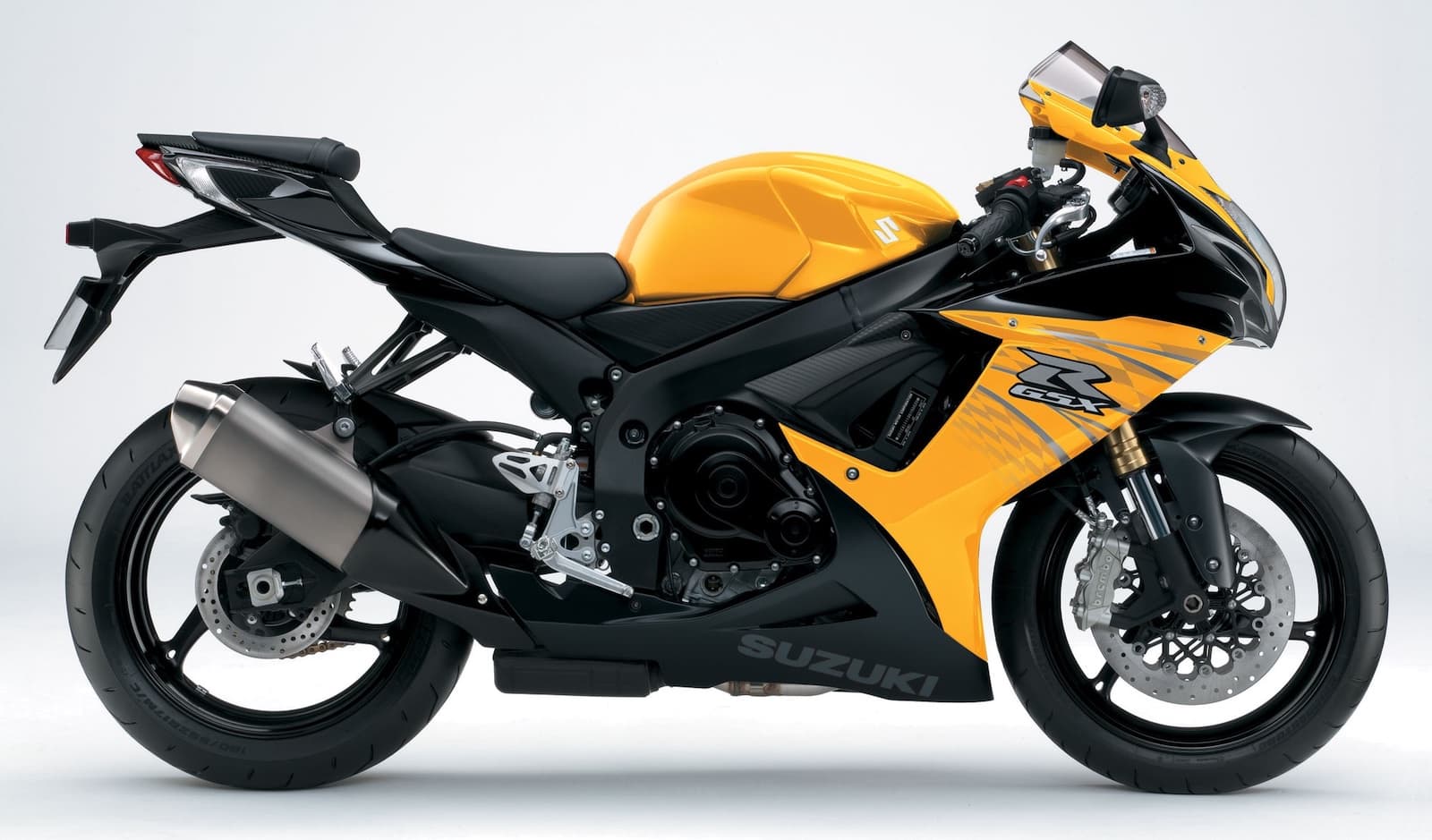Suzuki GSX-R 750 L1-L9 (2011+) Maintenance Schedule and Service Intervals
This is the maintenance schedule and associated service intervals for the Suzuki GSX-R750 L1-L9 (2011+).
The Suzuki GSX-R750 is Suzuki’s long-running “middleweight” sports bike, attempting to put a more powerful engine into the supersport GSX-R600 chassis, bridging the class before literbikes. It has over thirty years of history and obviously has evolved a lot!
The latest GSX-R750 is getting long in the tooth and is the longest-produced GSX-R750 without any major changes. It replaced the earlier K6-K10 GSX-R750, and there’s no word on whether there’ll be a replacement — many suspect it’ll fall victim to emissions regulations soon.
Or if it’s too much for you… try Suzuki’s stablemate the naked Suzuki GSX-S750. Still a lot of power, and you get more comfort, ABS, and a few other bits and pieces.
This site has links for things like oil and spark plugs from which we earn a commission (which unfortunately nobody can save, not even us). If you appreciate this work, then please use those links. Thanks!
What you might need to maintain your L1-L9/10 Suzuki GSX-R750
Here’s your shopping list for maintaining your GSX-R750. I’ve ordered it roughly in order of how often you’re likely to need these things.
| Part | Suzuki GSX-R750 (2011+) spec |
|---|---|
| Oil | Suzuki requires engine oil with JASO MA spec, or at least API SF/SG or SH/SJ spec. Many oils fit this. Suzuki recommends SAE 10W-40 weight Suzuki motor oil, but I wouldn’t over-think this and use another popular high-grade oil like Motul 7100 10W-40. |
| Oil filter | Use a Hiflofiltro HF138RC, which is a drop-in high-quality replacement used in a lot of Suzuki bikes. |
| Air filter | Use a K&N air filter as a drop-in replacement, part number SU-7511. |
| Spark plugs | The standard spark plug is NGK CR9E. |
| Brake fluid/Clutch fluid | Suzuki (like most motorcycles) requires DOT 4 brake and clutch fluid. |
| Brake pads | Most people upgrade their brake pads to EBC ones for better performance (and they’re very affordable). Use EBC part codes FA447HH (two pairs) for the front and FA436HH for the rear. |
| Coolant | Suzuki only requires a coolant that’s “compatible with an aluminium radiator”. Most motorcycle coolants are, and so a Valvoline Zerex G05 is a fine option. |
| Chain maintenance | Use either Motul chain paste or a complete Motul chain care kit for frequent chain servicing. |
| Grease | Always handy to have some lithium soap-based grease for external pivot points, like the kickstand. |
Suzuki GSX-R750 L1 (2011+) Maintenance Schedule
Below is the maintenance schedule for the Suzuki GSX-R750 L1-L9 (2011-2021).
Maintaining the GSX-R750 is a lot like maintaining most other sport bikes. Changing the oil and servicing the chain are your top priorities. Changing the coolant and brake/clutch fluid are your next. Apart from that, just check the valves and tighten/lubricate everything every now and then and “bob’s your uncle” as we say where I’m from.
NOTES:
- These intervals should be judged by the number of months or odometer reading, whichever comes first
- I= Inspect and clean, adjust, replace or lubricate as necessary.
- R= Replace
- T= Tighten
- Coolant: Replace every four years if using super long-life coolant, but every two years if using a normal variety (Suzuki “Green” coolant)
| mi x 1000 | 0.6 | 4 | 7.5 | 11 | 14.5 | |
|---|---|---|---|---|---|---|
| km x 1000 | 1 | 6 | 12 | 18 | 24 | |
| months | 2 | 12 | 24 | 36 | 48 | Periodic |
| Engine oil (Motul 7100 10W-40) | R | R | R | R | R | |
| Engine oil filter | R | – | – | R | – | |
| Air cleaner element (SU-7511) | – | I | I | R | I | |
| Spark plugs (NGK CR9E) | – | I | R | I | R | |
| Valve clearance | – | – | – | – | I | |
| Exhaust pipe bolts and muffler bolts | T | – | T | – | T | |
| Exhaust control valve | I | – | I | – | I | |
| Fuel hose | – | I | I | I | I | |
| Evaporative emission control system (if fitted) | – | – | I | – | I | |
| Throttle cable play | I | I | I | I | I | |
| PAIR (air supply) system | – | – | I | – | I | |
| Throttle valve synchronization | – | – | I | – | I | CA: inspect at break-in |
| Engine coolant “Super Long Life” variety (e.g. Motorex M3.0 Coolant or another alternative) | – | – | – | – | R | Replace every 4 years or 48000 km (29000 miles) |
| Radiator hoses | – | I | I | I | I | |
| Clutch cable play | – | I | I | I | I | |
| Brakes | I | I | I | I | I | |
| Brake hose | – | I | I | I | I | Replace every 4 years. |
| Brake fluid (Castrol DOT 4) | – | I | I | I | I | Replace every 2 years. |
| Tires | – | I | I | I | I | |
| Steering | I | – | I | – | I | |
| Front forks | – | – | I | – | I | |
| Rear suspension | – | – | I | – | I | |
| Chassis bolts and nuts | T | T | T | T | T | |
| Lubrication | Lubricate every 1,000 km (600 miles) |
Maintaining your Drive Chain on your Suzuki GSX-R750
Maintain your chain regularly. Either use a good-quality (and affordable) chain lube like Motul Chain Paste, or use a full on Motul Chain Care Kit to clean and restore a chain.
Suzuki recommends that you maintain your chain regularly according to the following schedule to keep your GSX-R750 in best running order.
| Chain maintenance item | Every |
|---|---|
| Check chain * Correct tension / slack (20-30mm / 0.8-1.2 in at loosest point) * Adequate lubrication * No excessive wear / damage | Ride (pre-ride check) |
| Clean and lubricate chain | 1000 km / 600 miles |
Damage includes loose pins, damaged rollers, dry or rusted links, kinked or binding links, excessive wear, and improper adjustment.
Tyre size and tyre pressure for the Suzuki GSX-R750 (2011-2021)
The manual for the Suzuki GSX-R750 recommends the following tyre sizes and pressures, as well as prescribing Bridgestone Battlax tyres. Of course, many adjust tyre pressure to suit their own preferences, and use whatever tyres they want.
| Tyre | Size | Tyre pressure (cold) | Brand(s) shipped with |
|---|---|---|---|
| Front | 120/70 ZR17 M/C 58W | 36 psi / 250 kPa | BRIDGESTONE BATTLAX BT016F G |
| Rear | 180/55 ZR17 M/C 73W | 41 psi / 290 kPa | BRIDGESTONE BATTLAX BT016R G |
About the Suzuki GSX-R750 L1 (2011-2021)

The 2011+ L1 Suzuki GSX-R750 is an improvement again on a winning formula. As of 2021, the L1-onward model is the longest ever produced GSX-R750 series without any major changes. This also means that it’s not likely to last forever — especially as it was never gifted ABS, or any other rider aids for that matter.
The new-for-2011 model was a significant change from the previous generation, though. Firstly, it was about 9 kg (20lb) lighter than the outgoing model, but still produced the same stomping power of about 120kW (150 hp) at the crank, or 95 kW (128 hp) at the rear wheel.
With a wet weight of under 200 kg (194 kg, or 428 lb to be exact — or even lighter on some testers’ scales), the GSX-R750 is fast.
The new GSX-R’s chassis is completely new, but the engine still didn’t receive the lavish attention that the GSX-R600 got. The engine is effectively the same as the previous generation, though some tuning work helps it make more mid-range and gives it higher fuel efficiency under normal use.
The GSX-R750’s engine is still a transverse four-cylinder engine with a very oversquare ratio, with 70mm pistons and a 48.7mm stroke. A number of MotoGP-derived technologies are used to let the gixxer’s motor run at high revs for long periods of time.
By keeping the reciprocating mass low and venting the case to reduce pumping losses, Suzuki ensures that more power makes it to the pavement. As always with short-stroke engines, torque takes a backseat to horsepower, but there’s plenty of torque nonetheless for everyday riding.
The L1 Suzuki GSX-R750 also got a clean and sleek body style with a new headlight, Brembo brake calipers at the front, and a lot of features to make it easier to ride, including “back torque-limiting” clutch.
Suspension on the GSX-R750 is a Showa Big Piston Fork at the front, and a Showa rear shock at the back — both with full adjustability.
Manual for the Suzuki GSX-R 750 L1-L9 (2011-2021)
The above maintenance schedule comes directly from the user’s manual for the Suzuki GSX-R 750 from the 2020 manual, consulting previous years to check for differences.

You can download it from Suzuki’s official website here.



























